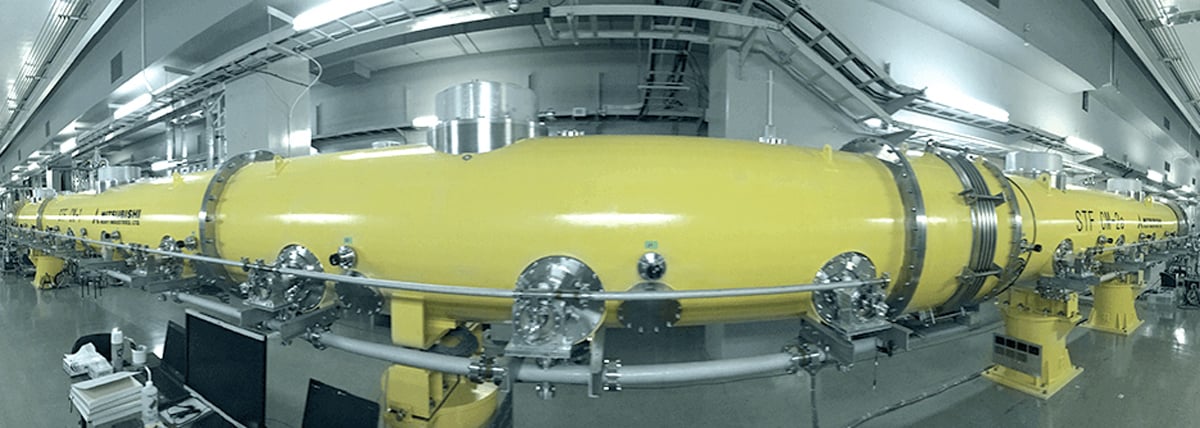Particle accelerators that clean power plants – and a lot more

Experimental physics rarely tops the news agenda, but the 2008 launch of the Large Hadron Collider (LHC) catapulted academic theories such as the search for the 'Higgs boson' -- also known as the "God Particle" -- into the spotlight.
Now, the European Organization for Nuclear Research (CERN) is planning for a successor of the LHC.
The new circular supercollider will sit next to its predecessor at CERN in Switzerland, but will be nearly three times its size, with a circumference of 100 kilometers. The Future Circular Collider (FCC) will pick up from the LHC to continue studying the smallest particles in the world.
Contributing to this revival of particle accelerators, the U.S. is getting its first new collider facility in decades, set to start operating around 2030. One of the missions of the Electro-Ion Collider (EIC) in New York will be to make particle acceleration more energy-efficient.
This should also impact the use of accelerators outside experimental physics. As successful as the LHC has been -- eventually finding the Higgs boson in 2012 -- particle accelerators come in many shapes and sizes. And they are used in a wide range of areas from radiation therapy for cancer to treating wastewater and cleaning flue gases from power plants.

How particle accelerators work
Particle accelerators move electrically charged particles -- typically protons and electrons -- at increasing speed through a vacuum, accelerating them to near the speed of light.
Particle accelerators were invented to investigate the structure of the atomic core, but research led to a variety of applications, including in energy.
Accelerators are either circular, with very strong magnets directing the particle stream around a loop, or linear, with the particles moving in a straight line from one end to the other.
Going back to the 1930s, when they were invented to investigate the structure of the atomic core, or nucleus, these facilities have been used for a range of research purposes. Over time, though, this research has also created many other everyday applications for accelerators.
Today, the technology can be found in anything from your local hospital to power plants.
Treating cancer more effectively
Linear electron acceleration has long been used in radiotherapy to create X-rays for treating cancer. More recently, proton and ion beams have entered the picture because they can deliver radiation with a higher degree of precision, making them particularly effective for treating certain types of tumors.
Ion-beam therapy has been shown to stop tumor growth in up to 90 percent of patients. The technology has become an accepted method of treatment, especially when malignant growths are located deep within the body or next to radiation-sensitive tissues and organs, such as the brainstem, optic nerve or intestine, which could be damaged by less focused irradiation.
Likewise, intensity-modulated radiation therapy (IMRT) -- a form of proton beam treatment that also involves particle accelerators -- uses both protons and photons to accurately target and shrink tumors without damaging the healthy tissue surrounding it.

Helping clean the environment
Accelerators may also offer us a way of dealing with any wastewater and flue gas emissions from power generation and industry that cannot be eliminated any other way.
With climate and environmental priorities rising, the idea of using accelerators for environmental clean-ups has moved back onto policymakers' and scientists' agendas.
More than 30 years ago, a pilot project in Miami-Dade County in the U.S. established that treating wastewater with electrons could remove a significant number of environmentally harmful substances, including chemicals and microorganisms. Other projects saw accelerators help remove toxic dyes from wastewater at a Korean textile factory and scrub sulfur dioxides and nitrogen oxides from flue gases at a power plant in Poland.
But further development in this area has been impeded by the cost, scale and complexity of accelerators.
With climate and environmental priorities rising, the idea of using accelerators for environmental clean-ups has moved back onto policymakers' and scientists' agendas.
Science portal Phys.org has reported that new initiatives are underway to make accelerator technology a more viable option. For example, researchers at the U.S. Department of Energy's Jefferson Laboratory are working on a portable accelerator to be used for environmental clean-up. It would be used to trigger a chemical reaction that converts nitrogen oxides and sulfur dioxides into ammonium nitrate and ammonium sulfate. These are used to make fertilizer, with ammonia lined up to become a carbon-free fuel alternative for ocean shipping.

Accelerators all around
It's fair to say that even beyond these applications, particle accelerators have pervaded our daily lives and the products we use, from making paint dry faster to changing the color of gemstones and screening our baggage at the airport.
With new large-scale accelerators like the FCC in Europe and the EIC in the U.S. set to launch over the next decade, the technology will continue to advance, with major projects like these and the LHC expected to trickle down to improve smaller-scale colliders in industry, healthcare, energy and many other areas.





